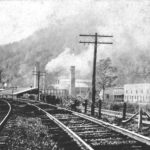Penn’s Creek
Penn’s Creek is the longest limestone stream in Pennsylvania. The scenic stream, which has its headwater near Penn’s Cave in Centre County, is known for outstanding fly fishing.

Penn’s Creek is the longest limestone stream in Pennsylvania. The scenic stream, which has its headwater near Penn’s Cave in Centre County, is known for outstanding fly fishing.

The manufacture of refractories – brick capable of withstanding extremely high temperatures – was one of Centre County’s major industries for more than seventy years. By the early 20th century, about 800 workers at eight brickyards were producing what was commonly known as fire brick.

Big Spring is a natural groundwater outlet found in Talleyrand Park in downtown Bellefonte, noteworthy for both its unique geology and its historical significance.The powerful spring forms a pool at the edge of the park.
Bellefonte attorney and gunsmith Jacob Roop opened Spring Creek Brewery in 1826 on property he purchased the previous year along Spring Creek. It became Centre County’s first successful brewery, operating for 76 years until 1902.

James Irvin was the ironmaster of Centre Furnace and the benefactor whose gift of 200 acres led to the establishment in Centre County of the Farmers’ High School of Pennsylvania, the future Penn State University.

The Bellefonte Academy was a popular private school that educated students from Centre County and across Pennsylvania for more than 125 years. The “School in the Mountains,” as it was known, operated from 1805-1934, except during the War of 1812 and Civil War.

The Bush House was a four-story hotel situated along Spring Creek in downtown Bellefonte built by Daniel G. Bush. Before it was destroyed by fire in 2006, it was a contributing property in the Bellefonte National Historic District.

Fred Lewis Pattee was an author, literary scholar, and English professor at Penn State. He wrote the alma mater and made numerous other contributions to the college. The Pattee Library is named for him.
Robert Cole was a self-trained architect who designed some of Bellefonte’s best-known buildings, as well as churches, homes and other structures in Centre County.
Julia Gregg Brill was the first female professor in Penn State’s English Department where she taught composition from 1924 to 1954. She was a tireless advocate for women and recognized by the university for her work.